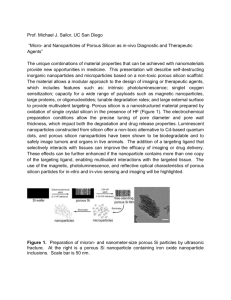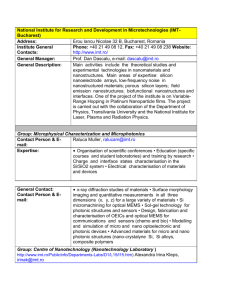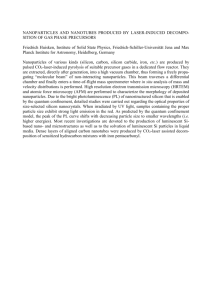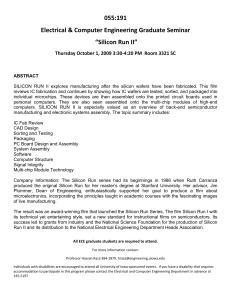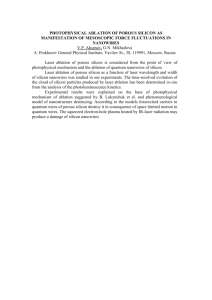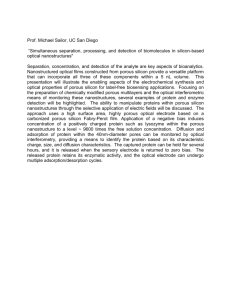Studying Silicon Nanotechnology at UCSD
advertisement
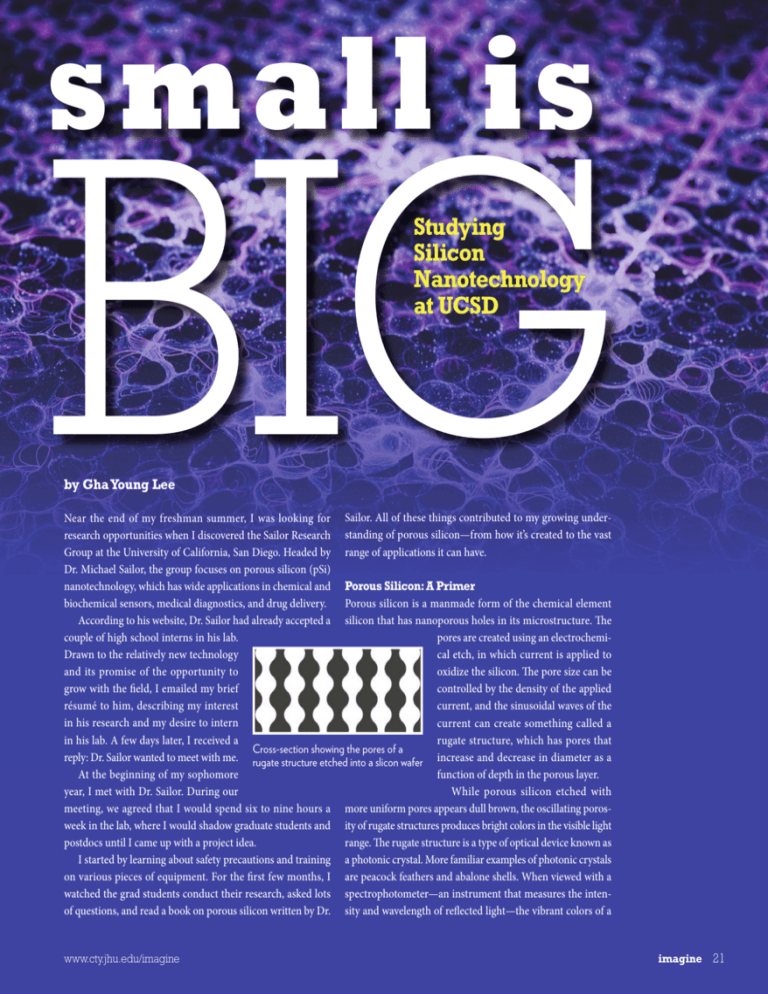
small is BIG Studying Silicon Nanotechnology at UCSD by Gha Young Lee Near the end of my freshman summer, I was looking for Sailor. All of these things contributed to my growing underresearch opportunities when I discovered the Sailor Research standing of porous silicon—from how it’s created to the vast Group at the University of California, San Diego. Headed by range of applications it can have. Dr. Michael Sailor, the group focuses on porous silicon (pSi) nanotechnology, which has wide applications in chemical and Porous Silicon: A Primer biochemical sensors, medical diagnostics, and drug delivery. Porous silicon is a manmade form of the chemical element According to his website, Dr. Sailor had already accepted a silicon that has nanoporous holes in its microstructure. The couple of high school interns in his lab. pores are created using an electrochemiDrawn to the relatively new technology cal etch, in which current is applied to and its promise of the opportunity to oxidize the silicon. The pore size can be grow with the field, I emailed my brief controlled by the density of the applied résumé to him, describing my interest current, and the sinusoidal waves of the in his research and my desire to intern current can create something called a in his lab. A few days later, I received a rugate structure, which has pores that Cross-section showing the pores of a reply: Dr. Sailor wanted to meet with me. rugate structure etched into a slicon wafer increase and decrease in diameter as a At the beginning of my sophomore function of depth in the porous layer. year, I met with Dr. Sailor. During our While porous silicon etched with meeting, we agreed that I would spend six to nine hours a more uniform pores appears dull brown, the oscillating porosweek in the lab, where I would shadow graduate students and ity of rugate structures produces bright colors in the visible light postdocs until I came up with a project idea. range. The rugate structure is a type of optical device known as I started by learning about safety precautions and training a photonic crystal. More familiar examples of photonic crystals on various pieces of equipment. For the first few months, I are peacock feathers and abalone shells. When viewed with a watched the grad students conduct their research, asked lots spectrophotometer—an instrument that measures the intenof questions, and read a book on porous silicon written by Dr. sity and wavelength of reflected light—the vibrant colors of a www.cty.jhu.edu/imagine imagine 21 rugate structure produce a spectrum with one or more sharp peaks. The spectrum of a normal pSi layer, in contrast, has no dominant peaks. The porosity of the rugate structure controls the spectral properties of the peaks, meaning that a rugate structure’s spectrum can be used to characterize its porosity as well as what is in the pores. Thus, the spectrum allows scientists to determine the refractive index of the material in the pores, whether it be air or liquid, which can in turn facilitate the process of identifying an unknown chemical substance. RACHEL BISIEWICZ, BROWN UNIVERSITY CLASS OF 2014 Promising Applications When the pores are filled with materials with a higher refractive index than air, the position of the spectral peak changes. Therefore, pSi can be used to detect gases, liquids, or any substance other than air, for that matter. For example, by measuring the elevated levels of acetone in a diabetic’s breath, pSi could potentially be used to detect or possibly monitor diabetes. It can also be used to detect proteins and enzymatic activity with great precision. Change in the reflectance peak of the pSi rugate structure in the presence of air (top) and ethanol (bottom) imaged and located. Accordingly, silicon nanoparticles are an aspect of silicon nanotechnology that is emerging as a leader in medical diagnostics and therapy. Demonstration of the change in color of pSi filled with air (left) and ethanol (right) Another application I found fascinating was the replication of pSi. Because silicon is brittle, replicating its structure with stronger, more flexible materials can allow for a wider variety of applications. For example, the pores can be filled with flexible plastics. When the silicon template is removed, the plastic is left, providing a negative of the original. If biodegradable polymers are used to replicate the porous structure, drugs can be loaded and sealed. This drug-loaded polymer can be implanted in the body to provide controlled release as the polymer gradually degrades, allowing for targeted, time-release therapies. In another significant etching technique called a lift-off, the etched portion of the silicon chip—approximately 100 micrometers thick—is separated from the bulk silicon wafer. This thin, brittle film has diverse applications. It can be broken down into porous nanoparticles which can then be loaded with drugs that release over time as the silicon degrades in the body. The nanoparticles can also be modified to target specific regions in the body, or even fluoresce so that the targeted region can be 22 imagine A Research Opportunity of My Own I’d worked in Dr. Sailor’s lab for about five months when I learned about the Summer School for Silicon Nanotechnology (SSSiN), funded by the National Science Foundation. This selective summer program, held at UCSD, is open to students from all over the world, from high schoolers to postdocs. I had learned a lot by shadowing in Dr. Sailor’s lab and was eager for the opportunity to conduct research. I applied to the program and was one of 25 participants accepted. The five-week summer program features lectures by Dr. Sailor and a mentored group project that focuses on a specific research topic. The program allows younger students to work with a scientist on a topic of their choosing. Since I was particularly interested in the polymer replication of pSi, I chose this topic and, along with the four other high school students in the summer school, worked with PhD student Joanna Wang. Unlike plastics, which are generally durable and stable, silicon is brittle and chemically unstable. Our goal was to come up with procedures to create a stable polystyrene replica that could have the sensing properties of porous silicon, but with Mar/Apr 2014 JOANNA WANG, UNIVERSITY OF CALIFORNIA, SAN DIEGO more structural and chemical stability. Although some previous attempts had been made to replicate polymers, the method used produced inconsistent results and poor replication, and this area remained largely unexplored. Not only would a perfected procedure have real-life applications such as the sensing of harmful gases, but it would also open the door for creating replicas of biocompatible polymers for possible drug delivery. While the application itself is similar to those of porous silicon, using the polymer to replicate the nanostructure was unique. At our first meeting, our group discussed the direction of the project. We would optimize the replication by varying infiltration methods, or ways of inserting the polymer in the pores. We chose two: melting the polymer with heat, and putting polymer dissolved in a solvent in the pores and evaporating the solvent out. For the next five weeks, we tested the parameters. It required much patience and constant hypothesis, feedback, discussion, and verification, using equipment that included a spectrophotometer and a scanning electron microscope. Ultimately, we found that melting the polymer into a partially oxidized lift-off replicated the structure best. We also found that the ability of polystyrene to replicate and retain the nanostructure depends on its viscosity and molecular weight. The polystyrene replica in air (left) and wetted with ethanol (right) Invaluable Information The summer program gave me the opportunity to participate in nanotechnology research, discuss ideas with professionals as we planned the next steps in the project, and gain a deeper understanding of the emerging field of porous silicon. It was also a chance to socialize with international participants with diverse backgrounds. Throughout the program, the groups ate lunch together and discussed their projects and past experiences in college, graduate school, and other research environments. Their wisdom and honest opinions about the field provided me with invaluable information and insight about the impact and beauty of STEM and the careers associated with it. We concluded the program with a series of presentations in which the groups shared their accomplishments and talked about their future plans. It was astounding to see how far each www.cty.jhu.edu/imagine group got, and how much the field was able to expand in one summer: One group came up with a novel method of controlling the size of silicon nanoparticles during the manufacturing of them; another optimized the conditions for manufacturing silicon nanoparticlecontaining polymers for drug delivery. Beyond SSSiN After SSSiN ended and the participants returned to their respective institutions, I was fortunate to be able to continue working in the lab with Joanna on our polystyrene project. We finalized our data showing the different peak shifts over time for each molecular weight and temperature. We also analyzed the peaks to better clarify the mechanisms of polymer infiltration of the rugate nanopores and identify important factors that affect successful replication of the rugate structure. Our project has been accepted for presentation at the 2014 Porous Semiconductors Science and Technology (PSST) conference that will be held in Spain in March. We also plan to submit a paper on the research in the near future. I am very proud that the five-plus weeks indeed paid off. I still intern at the Sailor lab with Joanna as my mentor. Currently, I’m working on a project involving replication of acrylic cross-linking polymers that will be even more stable than polystyrene, both chemically and mechanically. It represents a novel approach to polymer replication and, if successful, will provide an excellent alternative to the brittle silicon rugate. The acrylic polymer replicas, being structurally stronger, will be able to be used to sense a wider variety of materials than the polymer replicas manufactured thus far. I plan to present the project at the 2014 Greater San Diego Science and Engineering Fair. Researching pSi in Dr. Sailor’s lab and through the summer program not only provided me with amazing opportunities to explore nanotechnology. It confirmed my determination to pursue a career in science. Testing the parameters required much patience and constant hypothesis, feedback, discussion, and verification, using equipment that included a spectrophotometer and a scanning electron microscope. Gha Young Lee is a junior at Torrey Pines High School in San Diego, CA. She won first place at the San Diego Science Fair for her project on dielectric constants, and with her team, won the award for Best Experimental Measurements at the International iGEM Jamboree. At school, Gha Young founded the Inventions Club to encourage creativity in her fellow students. imagine 23
